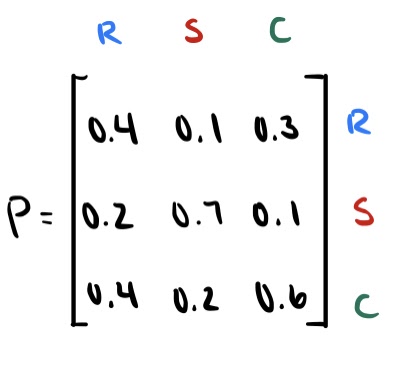(Created page with "Category:Walther MA271 Fall2020 topic2 =Transition Probability Matrix= However, using a tree diagram also has its limitations: if we want to calculate the probability af...") |
|||
| Line 5: | Line 5: | ||
However, using a tree diagram also has its limitations: if we want to calculate the probability after a month or even half a year, the tree diagram method will no longer be efficient. Therefore, mathematicians adopted the calculation method using Matrix. The matrix below is called the “transition probability matrix”. | However, using a tree diagram also has its limitations: if we want to calculate the probability after a month or even half a year, the tree diagram method will no longer be efficient. Therefore, mathematicians adopted the calculation method using Matrix. The matrix below is called the “transition probability matrix”. | ||
| − | <math>\left(\begin{array}{cccc} | + | <math>\left(\begin{array}{cccc}P_{11}&P_{12}&...&P_{1n}\\P_{21}&P_{22}&...&P_{2n}\\...&...&...&...\\P_{m1}&P_{m2}&...&P_{mn}\end{array}\right)</math> |
| + | |||
| + | Just as its name implies, each element inside the transition probability matrix describes a transition probability from state to another. Here, <math>P_{11}</math>represents the probability of event 1 occurring again on the second day after event 1 occurred on the first day; <math>P_{21}</math> represents the probability of event 1 occurring on the second day after event 2 occurred on the first day… and so on and so forth. Using this method, the transition probability matrix of the weather example can be written as: | ||
| + | |||
| + | <center>[[File:Markovmatrix.jpg|500px|thumbnail|center]]</center> | ||
| + | |||
| + | |||
| + | |||
| + | [[Category:MA271Fall2020Walther]] | ||
Revision as of 23:57, 5 December 2020
Transition Probability Matrix
However, using a tree diagram also has its limitations: if we want to calculate the probability after a month or even half a year, the tree diagram method will no longer be efficient. Therefore, mathematicians adopted the calculation method using Matrix. The matrix below is called the “transition probability matrix”.
$ \left(\begin{array}{cccc}P_{11}&P_{12}&...&P_{1n}\\P_{21}&P_{22}&...&P_{2n}\\...&...&...&...\\P_{m1}&P_{m2}&...&P_{mn}\end{array}\right) $
Just as its name implies, each element inside the transition probability matrix describes a transition probability from state to another. Here, $ P_{11} $represents the probability of event 1 occurring again on the second day after event 1 occurred on the first day; $ P_{21} $ represents the probability of event 1 occurring on the second day after event 2 occurred on the first day… and so on and so forth. Using this method, the transition probability matrix of the weather example can be written as:


